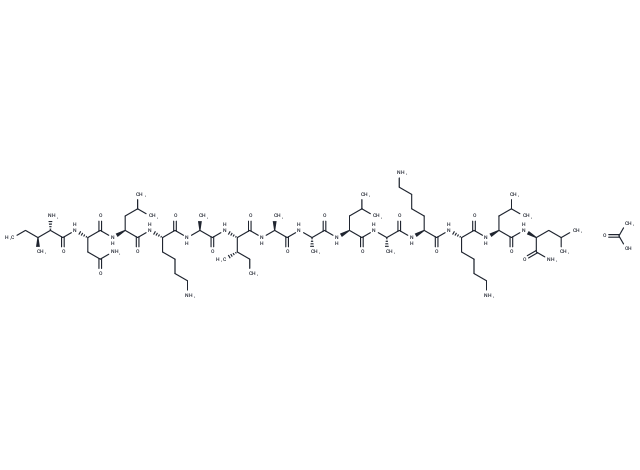Shopping Cart
- Remove All
 Your shopping cart is currently empty
Your shopping cart is currently empty

Mastoparan acetate is a peptide toxin from wasp venom. It has the chemical structure Ile-Asn-Leu-Lys-Ala-Leu-Ala-Ala-Leu-Ala-Lys-Lys-Ile-Leu-NH2.

| Pack Size | Price | Availability | Quantity |
|---|---|---|---|
| 1 mg | $91 | In Stock | |
| 5 mg | $368 | In Stock | |
| 10 mg | $577 | In Stock | |
| 25 mg | $926 | In Stock | |
| 50 mg | $1,260 | In Stock | |
| 100 mg | $1,680 | In Stock |
| Description | Mastoparan acetate is a peptide toxin from wasp venom. It has the chemical structure Ile-Asn-Leu-Lys-Ala-Leu-Ala-Ala-Leu-Ala-Lys-Lys-Ile-Leu-NH2. |
| In vitro | Mastoparan has an amphiphilic nature and is reported to exert a variety of pharmacological and biochemical effects. Mastoparan induces exocytosis of hormones from anterior pituitary cells. Mastoparan stimulation of prolactin secretion is dose-dependent, time-dependent, reversible and required the presence of calcium. Mastoparan causes translocation of protein kinase C activity from a soluble to a membrane-attached form. Mastoparan is able to increase the intracellular Ca2+ concentration in Fura-2-loaded individual lactotrophs. Mastoparan is also able to interact with GTP-bindmg proteins. Thus, Mastoparan has been shown to facilitate exchange of nucleotides and to stimulate GTPase activity on G-proteins. It has therefore been proposed that the cellular effects of Mastoparan are due to an ability to mimic G-protein-linked agonist-liganded receptors[1]. |
| Molecular Weight | 1538.99 |
| Formula | C72H135N19O17 |
| Cas No. | 79396-78-4 |
| Smiles | O=C([C@@H](NC([C@@H](NC([C@@H](NC([C@@H](NC([C@@H](NC([C@@H](NC([C@@H](NC([C@@H](NC([C@@H](NC([C@@H](NC([C@@H](NC([C@H]([C@H](CC)C)N)=O)CC(N)=O)=O)CC(C)C)=O)CCCCN)=O)C)=O)[C@H](CC)C)=O)C)=O)C)=O)CC(C)C)=O)C)=O)CCCCN)=O)CCCCN)N[C@H](C(N[C@@H](CC(C)C)C(N)=O)=O)CC(C)C.CC(O)=O |
| Relative Density. | no data available |
| Storage | keep away from moisture | Powder: -20°C for 3 years | In solvent: -80°C for 1 year | Shipping with blue ice. | ||||||||||||||||||||
| Solubility Information | DMSO: 10 mM, Sonication is recommended. | ||||||||||||||||||||
Solution Preparation Table | |||||||||||||||||||||
DMSO
| |||||||||||||||||||||

Copyright © 2015-2025 TargetMol Chemicals Inc. All Rights Reserved.